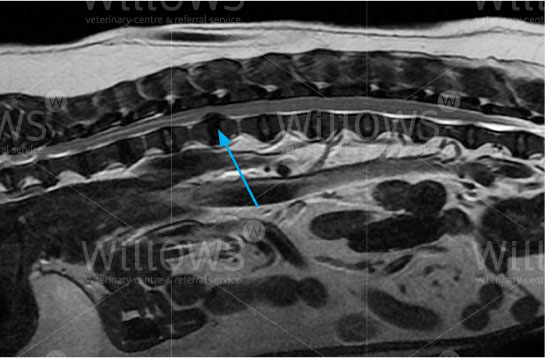Thoracolumbar Disc Disease

News

Why Should I Bring my Pet to Willows for Treatment of Thoracolumbar Disc Disease?
Willows is one of Europe’s leading small animal referral centres. Our state-of-the-art hospital in the West Midlands is led by internationally renowned Specialists, committed to providing the highest standards of veterinary care. Our team of Specialist Neurosurgeons have extensive experience, having treated thousands of dogs with thoracolumbar disc disease, providing gold standard management and treatment for all our patients.
Our Specialist Neurosurgeons are supported by our multi-disciplinary team of Specialists across a number of different disciplines including; Anaesthesia, Diagnostic Imaging and Emergency and Critical Care. Willows also has a large dedicated team of Vets, Nurses, Physiotherapists and clinical support staff available 24 hours a day, every day of the year to provide the best possible care for your pet.

Heading What is the Intervertebral Disc?
The discs are the structures between the bones of the spine (vertebrae) that act as shock absorbers. They consist of a soft centre (the nucleus pulposus) inside a fibrous ring (the annulus fibrosus).

How does Thoracolumbar Disc Disease Occur?
A more common term for thoracolumbar disc disease is a ‘slipped disc’ in the back. As in people, discs in dogs degenerate as they get older. This process results in the discs becoming dehydrated and losing their cushioning effect. They may then ‘slip’ in one of two ways. Firstly, the material in the centre of the disc can come out of the fibrous ring and injure the spinal cord (this is called a disc extrusion). Secondly, the fibrous ring may thicken and compress the spinal cord (this is called a disc protrusion). Either type of ‘slipped disc’ may cause back pain and spinal cord injury.
What are the Signs of Thoracolumbar Disc Disease?
The signs of thoracolumbar disc disease can vary depending on whether the disc has an extrusion or protrusion, and the degree of spinal cord injury.
- A wobbly or weak back leg walking pattern
- Spinal pain which can appear as an arched back and tight abdominal muscles
- In more severe cases there can be loss of ability to walk or complete paralysis of the back legs
These signs can occur slowly (several weeks to months) or very rapidly (sometimes over a few minutes to hours), but most dogs will show signs developing over a few days.

How is Thoracolumbar Disc Disease Diagnosed?
Often, patient history and an examination provide enough information to reach a diagnosis of thoracolumbar disc disease. Checking the dog’s ability to feel pain in the back legs and tail is also important. The examination often helps the Specialist to localise which area of the spine is affected. To confirm the diagnosis and identify the site of the problem for surgical planning, advanced diagnostic imaging (usually an MRI scan) will be recommended.
Fig 1: MRI scan showing a slipped disc in the back


How can Thoracolumbar Disc Disease be Treated?
The two principle methods of managing thoracolumbar disc disease are:
Conservative treatment: In dogs with thoracolumbar disc disease undergoing conservative treatment exercise must be restricted. Short lead walks for toileting purposes may be necessary, with strict confinement at other times. The hope is that the ‘slipped disc’ will heal, any back pain subside and the spinal cord recover from any injury. Painkillers may be necessary and possibly other drugs, such as muscle relaxants.
Surgery: The aims of surgery are to remove any disc material compressing the spinal cord and to prevent any more disc material ‘slipping’. Decompressive surgery involves making a window in the bone around the spine (laminectomy) to enable retrieval of disc material. Further ‘slipping’ can be prevented by cutting a small window in the side of the disc and removing material in the centre (disc fenestration). Occasionally vertebral stabilisation (fusion) procedures are necessary, especially in large dogs.

What Can I Expect if my Dog is Treated for Thoracolumbar Disc Disease?
Following surgery, a two to seven day period of hospitalisation with us at Willows is typically needed for pain relief and to monitor for return of voluntary urination as many dogs require their bladder to be emptied manually. A few dogs may be discharged with a urinary catheter in place, and you will be instructed how to use this to prevent the bladder from over-filling.
Exercise following surgery must be restricted for around four to six weeks during the healing process. After a few weeks, controlled exercise (on a lead) may be gradually increased and hydrotherapy may be recommended. Physiotherapy is very important and instructions will be provided for you to carry this out at home.
Approximately 85% of mildly affected dogs have successful conservative treatment and avoid the need for surgery. More severely affected dogs that have lost the ability to walk are usually treated with surgery however, the outlook is generally very good with over 90% of these dogs regaining the ability to walk well. Even the most severely affected dogs that lose the ability to feel their toes have a 60% chance of recovery with surgery.
To save this page as a PDF, click the button and make sure “Save as PDF” is selected. Print This Page
Neurology
Find out more
To assist owners in understanding more about Neurological conditions, investigations and treatment we have put together a range of information sheets to talk you through the some of the more common neurological conditions seen by our Specialists.

